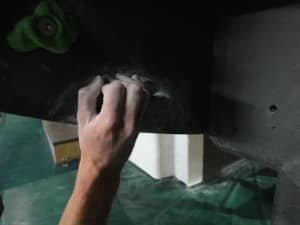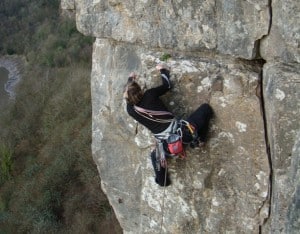Climbing as we have already established is about reading the route and the holds you are going to use.

If you overreach, you are less likely to be ale to use the hold, but if you work your feet up and adjust your hands on the holds you will be able to move up the wall more efficiently, you will also have a more open body position and be able to see the footholds more easily.
Some holds are easy to read, for example a jug, which is a big hold you can curl most or all your fingers around or into. As you move up using your feet, the jug may be better used as a side pull. This is true of almost any type of hold; side pulls enable you to lean off left or right giving depth of movement to your climbing and not just thinking in a straight upward line. This becomes more relevant when you take climbing outdoors.

Finger holds or crimps vary not only in depth but can restrict the number of fingers you can use.
With a closed crimp the fingers will be in an arched position with the thumb across the top of your index finger for support. Using closed crimps can lead to tendon injuries as the right angle created in the first joint of the finger can cause the tendon to take a short cut across the right angle causing the tendon to pop out of its sheath. With an open crimp the fingers will be straighter, which will put less stress on the tendons and the thumb not always able to give support, but look for ways to get added pressure from the thumb. Finger strength takes
With an open crimp the fingers will be straighter, which will put less stress on the tendons and the thumb not always able to give support, but look for ways to get added pressure from the thumb. Finger strength takes time to develop, another reason to warm up and progress through the grades.
Large rounded holds are called slopers and require an open handed position. An extended arm keeping the body below the hold is essential. It might be useful to look at, feel and experiment with different holds whilst at ground level, either in the climbing centre or in the the bouldering room if there is one available, in order to see all the possibilities a hold has to offer.
A sloper might have a hidden side pull. An upside down jug becomes an undercut, allowing you to move outwards and upwards.
With some moves you will have to match, or swap hands on the hold in order to free up the other hand. This is also true  of the feet. There are several ways to do this, and are similar for both the hands and feet. The terminology may give you a clue: the hop, the tablecloth, the roll and the peeler. You can also cross through with the hands and/or the feet. Whatever you choose, plan ahead and have fun trying.
of the feet. There are several ways to do this, and are similar for both the hands and feet. The terminology may give you a clue: the hop, the tablecloth, the roll and the peeler. You can also cross through with the hands and/or the feet. Whatever you choose, plan ahead and have fun trying.
As you get familiar with using holds for hands and feet your movement will become more fluid. Many climbers move statically which is secure but limits fluidity and is not as efficient. It is the ability to place the foot, transfer your weight onto it and push off with an almost dance like quality, so there is no beginning or end to the movement, that turns a static climber into one who climbs efficiently and flows up the wall. Children are naturally dynamic climbers, using their momentum to reach the next hold. A good balance can be found somewhere between the two.